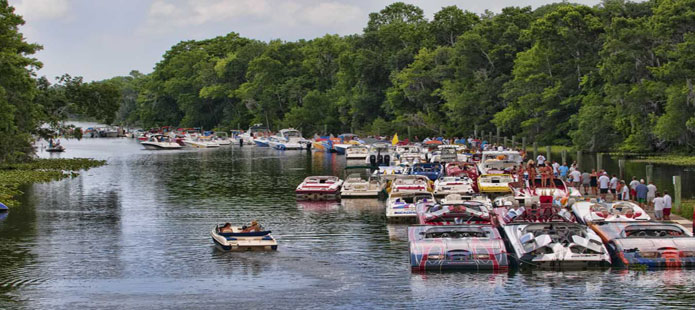Image of the Week: The Perfect Raft-Up
The first time I saw a group of powerboats raft-up to one another was more than 15 years ago at the Lake Texoma Poker Run. My editor at the time, Eric Colby if my faulty memory serves, decided it was time to send me out on the road for a heavy-dose of go-fast boat reality. So he assigned me coverage of the Lake Texoma Poker Run.
What a heavy dose of the go-fast boat world it was. I spent the weekend hanging out with throttling great Jerry Gilbreath and boat- building legend Reggie Fountain at a mind-blowing waterside “shack” owned by Lake Texoma regular, Doug Frank. While I’m pretty sure neither Gilbreath nor Fountain actually knew I was “hanging out” with them, Frank and I became fast friends. And I never forgot the experience of that weekend. It was—larger than life.
A perfectly executed raft-up, like this one at the 2011 Jackson River Rally Poker Run, is a thing of beauty. Photo courtesy/copyright Jay Nichols/Naples Image.
The other thing I never forgot about that run was experiencing my first-raft up. When I saw what all these guys in monster go-fast boats were about to do—or try to do—I was horrified. Tie together a bunch of expensive, heavy, bobbing fiberglass toys with expensive paint jobs in a line with only fenders to keep them from destroying one another? It seemed like a recipe for disaster.
And yet when it happened, it came together like a Blue Angels formation. OK, maybe it wasn’t quite that pretty or precise, but I was impressed. In a matter of 15 minutes, there were three lines of six to ten big go-fast boats neatly tied together, and they formed three giant floating gangways to the dock.
There are few things in the high-performance powerboat world that still impress me as much as a well-orchestrated and executed raft-up. (And, oh yes, I’ve seen it go the other way. Oh yes.) Little like things, things like “everyone point the nose of your boat into the current,” make a difference, but it really comes down to driver touch and low-speed operational skills in vessels that, generally speaking, aren’t all that responsive and agile at low speeds.
And when it’s done right, as in the Jay Nichols photo above, it’s a thing of beauty.


